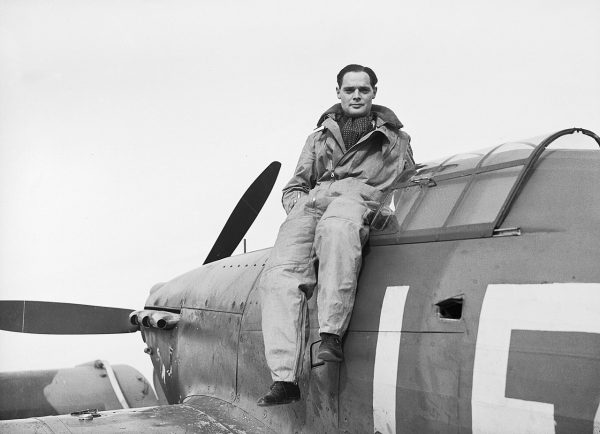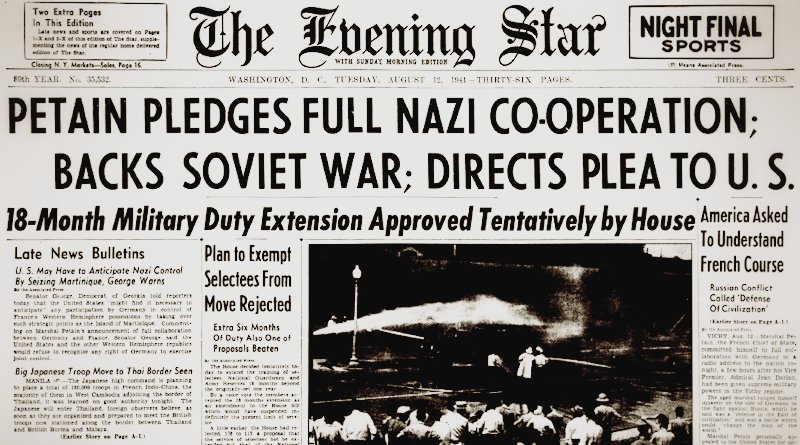World War II Chronicle: August 12, 1941
Click here for TODAY’S NEWSPAPER
On the first two pages, officials are debating the new $35,000,000 “War Building” that will sit near Arlington National Cemetery… Seven American airmen perished along with eight Canadian, six British, and an Australian crewmen when a ferry bomber crashed yesterday in Scotland (front page). A Consolidated LB-30 flown by the Atlantic Ferry Organization (ATFERO) was beginning a transatlantic trip to Gander, Newfoundland1Newfoundland was a dominion of the United Kingdom and didn’t join Canada until 1949 when it ran into clouds after taking off from RAF Heathfield. The plane drifted off course, slamming into a mountain on the Isle of Arran.

The Duke of Kent boarded this aircraft two weeks ago and became the first member of the Royal Family to cross the Atlantic by plane. British Overseas Airway Corp. (BOAC) Captain Ernest R. Bristow, from was the pilot. He was born in India and joined the Royal Air Force as a boy mechanic2The RAF permitted boys from 15 to 17 years old join and work in certain trades, working his way up to sergeant-pilot. Last year he served as navigator on the first wartime transatlantic flight. Air Transport Auxiliary captain Francis D. Bradbrooke was co-pilot.
RAF Ferry Command passengers include Capt. Josiah J. Anderson, Radio Officer John B. Drake, Capt. Daniel J. Duggan (Cambridge, Mass.), Capt. George T. Harris, (Lawrence, Kan.), Capt. Harold C.W. Smith, Flight Engineer Ernest G. Reeves (Somerville, N.J.). Wilfrid G. Kennedy, George Laing, and William K. Marks were RAF radio officers. Albert A. Oliver, Herbert D. Rees, Radio Officer Hugh C. McIntosh and George H. Powell served as Air Transport Auxiliary radio officers. Henry S. Green was a radio officer from BOAC. Capt. John E. Price was the lone Australian.
Capt. Jack Wixen (born Jacob Vichnenko) was a pilot and instructor for Transcontinental & Western Air and American Airlines before joining RAF Ferry Command. He and his Jewish family fled Russia to Palestine, then settled in Los Angeles. First Officer John J. Rouleston was also from Los Angeles.
Capt. Hoyt R. Judy flew for the U.S. Navy before volunteering for the RAF. Capt. Watt M. King (Mineral Wells, Texas) flew in the Army Air Corps, was a test pilot, and did barnstorming before joining ATFERO. Radio Officer Ralph B. Brammer’s older brother Stuart volunteered to take his fallen sibling’s place as a radio operator for the RAF…
Sports section begins on page 15… On page 20: the Royal Air Force reports that two famous aces are missing after cross-channel raids: Wing Commander Douglas R. Bader (pictured on page three) and Acting Flight Lieutenant Eric S. Lock. Bader lost both of his legs — one above the knee and one below — but learned to fly with prosthetics. Not counting shared victories and probables, Bader shot down 22 enemy planes during the war.

During the Battle of Britain Lock shot down German warplanes within a week, earning his first Distinguished Flying Cross and earned a second just three weeks later, splashing 15 in just 19 days. He had to bail out of his own aircraft three times during this period. Had he not spent six months in the hospital recovering from shrapnel wounds from being shot down on another occasion, “Sawn-off Lockie” would likely have many more than his 26 victories.

Evening star. (Washington, D.C.), 12 August 1941. Chronicling America: Historic American Newspapers. Lib. of Congress.
https://chroniclingamerica.loc.gov/lccn/sn83045462/1941-08-12/ed-1/
